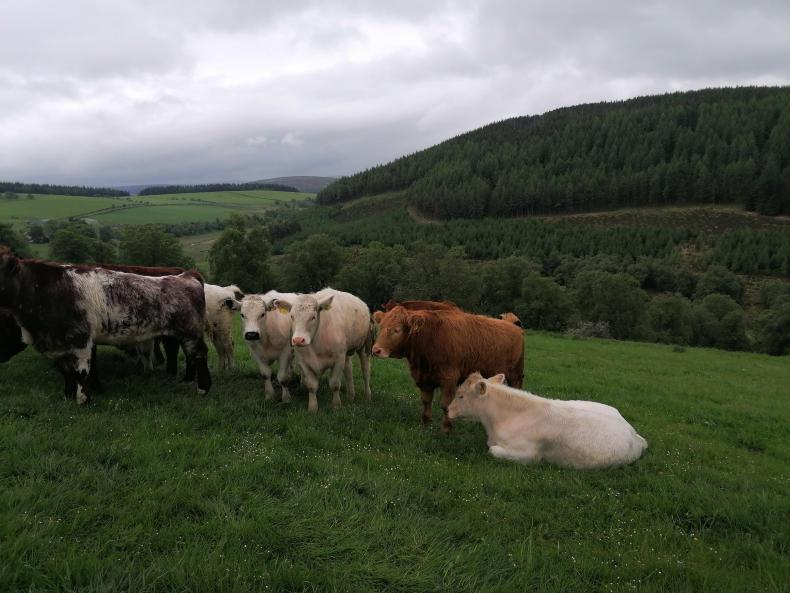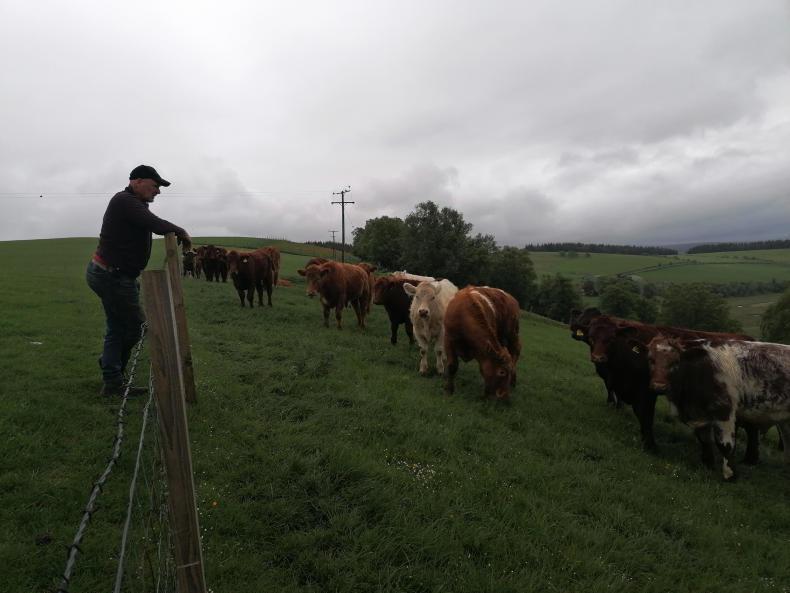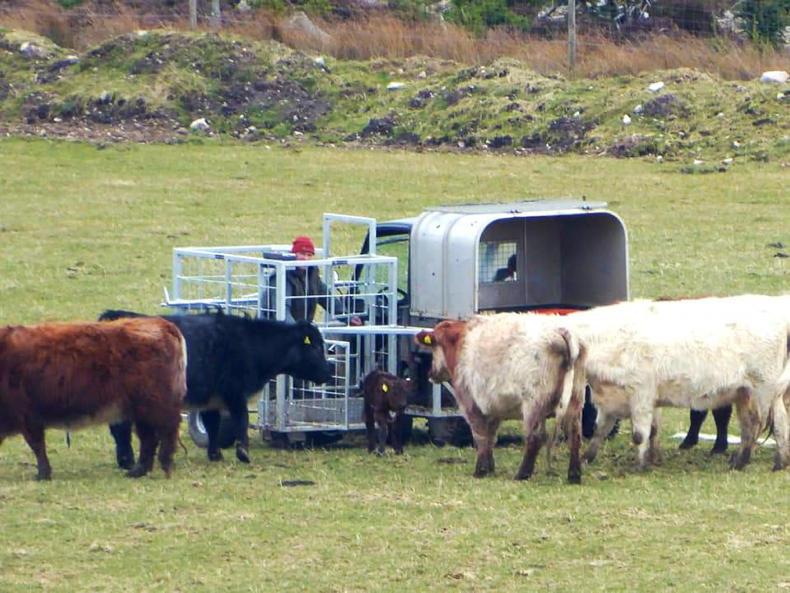This week, we caught up with the action at Main of Auchriachan near Tomintoul in Aberdeenshire. Here, Andy and Debbie Duffus run suckler cows and sheep on 1,500ha of hill and in-bye ground.
Unlike years past, this year Andy and Debbie have kept the ewes and lambs on the in-bye ground. Usually the sheep are gathered up after lambing and moved out on to the hill by the beginning of June.
This year, with the improvements in soil fertility starting to show through, there is a surplus of grass in-bye and the ewes will hopefully not go to the hill until weaning in the third week of July.
With the sheep remaining on the improved pasture, this should allow some lambs be sold prime soon after weaning.
Andy is happy with the lambs that were sired by the Texel and New Zealand Suffolk cross tups.

Andy has seen significantly good grass growth this year which is above the typical Scottish farm.
The sheep are all on fenced improved ground and one lot of 70 Mules with lambs is grazing on a rotational system.
The Mules have 1.5 lambs each and are co-grazing with 25 Highland and Luing cross steers and three fattening cows.
They are on an 18 acre field that has been split into three paddocks and while conditions were dry, the grass grew well and kept pace with their demand.
Next year, Andy plans to further increase the amount of rotational grazing on farm. It is also encouraging to see that the work that has been done improving the pH, P and K status of the grazing has really started to take effect and some fields have only had half the nitrogen planned due to strong early season grass growth.
Bulling plan
The hill herd of 30 Highland and Shorthorn cross cows with their calves has been split into two bulling groups and are currently being rotated on hill parks.
One lot of 15 is going to the Highland bull while the other 15 will go to the Shorthorn bull.

Andy and Debbie's cattle out with the Shorthorn bull.
The bulls went in last Friday and will be in for 10 to 11 weeks. Andy plans to calve the hill herd outside again next year and he believes it was a real success this year with few issues.
The beauty of the system is that they will always have spare housing to take them in to if the weather turns.
“The plan is to check the calf, tag it then leave it alone,” said Andy. “Inside calves were a lot more work than outside this year, but we did have a mild winter.”

Andy is using a Charolais and Shorthorn bulls with his indoor suckler herd.
This year, they started calving at the start of April and his own bred cows were all finished within seven to eight weeks.
He hopes to push the calving back a couple of weeks to reduce the number being born during lambing which starts in April.
The bulls are also out with the indoor spring-calving herd. One batch of 26 Simental cross suckler cows is with the Charolais bull while the other 21 Shorthorn-cross Highland cows have been put back to the Shorthorn.
Turnips
This year, turnips have returned to Auchriachan for the first time in 30 years. Previously deer would eat any crop of neeps attempted near Tomintoul.
However, with more deer fences having been erected on the farm, Andy has planted the winter fodder crop.
Further, there is a carryover of 400 bales of silage and a month’s worth of silage in the pit, so Andy feels be can be a bit more adventurous with his winter feed plan.
Fifteen acres have been planted on the flat with the plan to start grazing cattle on them from November onwards.

Andy's tagging calves earlier this spring.
Fencing frustration
After a successful AECS application, Andy has a lot of fencing to do for a forestry scheme to create shelter belts and hill parks on the hill ground.
Unfortunately, the start has been held up thanks to a five-week waiting list for materials.
There is a real shortage of large 100mm to 110mm round posts. Square or smaller posts are not an option on Andy’s hard ground, which he describes as a like chopping into a quarry after a mild spring.
Farm profile
Andy and Debbie Duffus farm at Mains of Auchriachan near Tomintoul in Aberdeenshire. They run 115 suckler cows and 600 ewes on their farm.
With it coming up to 12 weeks since many sheep flocks hit the peak of lambing, considerations must now turn to getting the lambs weaned.
One of the successes at Auchriachan has been an uplift in the lamb numbers and this is partially down to having the ewes in optimum condition at tupping.
A major contributing factor to this is getting the lambs weaned early and allowing the ewes to recover body condition.
This also means that the lambs can be kept on the best grazing for now and prioritised.
This will increase their growth rate as they won’t be competing with their mothers for the best grass and will get the lambs out of the system quicker.
Again, at Auchriachan, with weaning the lambs a month sooner than previously, Andy managed to increase the number of lambs sold prime from around 50 per year to nearly all of the sale lambs last year.
Over the previous three years, lambs averaged £42/head to £51/head between the store and prime sales. Last year, the lambs averaged £84/head, a near doubling in value.
This week, we caught up with the action at Main of Auchriachan near Tomintoul in Aberdeenshire. Here, Andy and Debbie Duffus run suckler cows and sheep on 1,500ha of hill and in-bye ground.
Unlike years past, this year Andy and Debbie have kept the ewes and lambs on the in-bye ground. Usually the sheep are gathered up after lambing and moved out on to the hill by the beginning of June.
This year, with the improvements in soil fertility starting to show through, there is a surplus of grass in-bye and the ewes will hopefully not go to the hill until weaning in the third week of July.
With the sheep remaining on the improved pasture, this should allow some lambs be sold prime soon after weaning.
Andy is happy with the lambs that were sired by the Texel and New Zealand Suffolk cross tups.

Andy has seen significantly good grass growth this year which is above the typical Scottish farm.
The sheep are all on fenced improved ground and one lot of 70 Mules with lambs is grazing on a rotational system.
The Mules have 1.5 lambs each and are co-grazing with 25 Highland and Luing cross steers and three fattening cows.
They are on an 18 acre field that has been split into three paddocks and while conditions were dry, the grass grew well and kept pace with their demand.
Next year, Andy plans to further increase the amount of rotational grazing on farm. It is also encouraging to see that the work that has been done improving the pH, P and K status of the grazing has really started to take effect and some fields have only had half the nitrogen planned due to strong early season grass growth.
Bulling plan
The hill herd of 30 Highland and Shorthorn cross cows with their calves has been split into two bulling groups and are currently being rotated on hill parks.
One lot of 15 is going to the Highland bull while the other 15 will go to the Shorthorn bull.

Andy and Debbie's cattle out with the Shorthorn bull.
The bulls went in last Friday and will be in for 10 to 11 weeks. Andy plans to calve the hill herd outside again next year and he believes it was a real success this year with few issues.
The beauty of the system is that they will always have spare housing to take them in to if the weather turns.
“The plan is to check the calf, tag it then leave it alone,” said Andy. “Inside calves were a lot more work than outside this year, but we did have a mild winter.”

Andy is using a Charolais and Shorthorn bulls with his indoor suckler herd.
This year, they started calving at the start of April and his own bred cows were all finished within seven to eight weeks.
He hopes to push the calving back a couple of weeks to reduce the number being born during lambing which starts in April.
The bulls are also out with the indoor spring-calving herd. One batch of 26 Simental cross suckler cows is with the Charolais bull while the other 21 Shorthorn-cross Highland cows have been put back to the Shorthorn.
Turnips
This year, turnips have returned to Auchriachan for the first time in 30 years. Previously deer would eat any crop of neeps attempted near Tomintoul.
However, with more deer fences having been erected on the farm, Andy has planted the winter fodder crop.
Further, there is a carryover of 400 bales of silage and a month’s worth of silage in the pit, so Andy feels be can be a bit more adventurous with his winter feed plan.
Fifteen acres have been planted on the flat with the plan to start grazing cattle on them from November onwards.

Andy's tagging calves earlier this spring.
Fencing frustration
After a successful AECS application, Andy has a lot of fencing to do for a forestry scheme to create shelter belts and hill parks on the hill ground.
Unfortunately, the start has been held up thanks to a five-week waiting list for materials.
There is a real shortage of large 100mm to 110mm round posts. Square or smaller posts are not an option on Andy’s hard ground, which he describes as a like chopping into a quarry after a mild spring.
Farm profile
Andy and Debbie Duffus farm at Mains of Auchriachan near Tomintoul in Aberdeenshire. They run 115 suckler cows and 600 ewes on their farm.
With it coming up to 12 weeks since many sheep flocks hit the peak of lambing, considerations must now turn to getting the lambs weaned.
One of the successes at Auchriachan has been an uplift in the lamb numbers and this is partially down to having the ewes in optimum condition at tupping.
A major contributing factor to this is getting the lambs weaned early and allowing the ewes to recover body condition.
This also means that the lambs can be kept on the best grazing for now and prioritised.
This will increase their growth rate as they won’t be competing with their mothers for the best grass and will get the lambs out of the system quicker.
Again, at Auchriachan, with weaning the lambs a month sooner than previously, Andy managed to increase the number of lambs sold prime from around 50 per year to nearly all of the sale lambs last year.
Over the previous three years, lambs averaged £42/head to £51/head between the store and prime sales. Last year, the lambs averaged £84/head, a near doubling in value.










 This is a subscriber-only article
This is a subscriber-only article











SHARING OPTIONS: